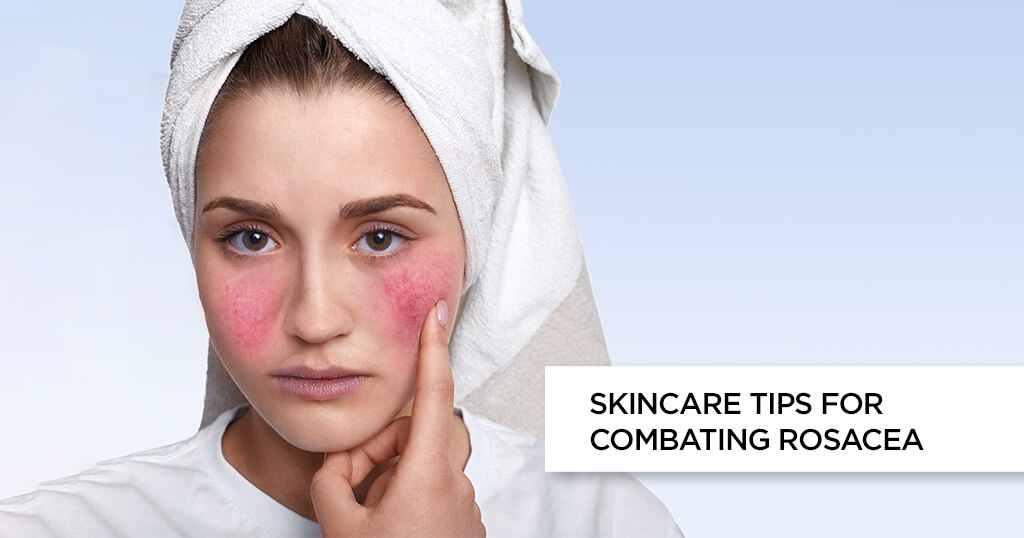Worlds Knowledge in Your Pocket.
"Share your knowledge. It is a way to achieve immortality." by Dalai Lama
Worlds Knowledge in Your Pocket.
"Share your knowledge. It is a way to achieve immortality." by Dalai Lama

Rosacea is a skin disorder that causes the face to become red and flushed. It can also cause tiny, pus-filled pimples. These signals and symptoms may flare up for weeks to months before fading away again. Rosacea may be confused with acne, other skin conditions, or natural rosiness.
In men, rosacea can lead to a watery nose from nasal polyps. In women, it may lead to a bloated feeling in the face or a swollen red nose from a cyst. It is not clear what causes it, but scientists think that genetics and environmental factors –such as sun exposure – play a role. Exposure to tobacco and very hot drinks may also trigger a rosacea attack.
It is a chronic condition, but it can also be controlled with lifestyle changes and medical treatment. Treatments may include medication, moisturizers, sun protection, laser therapy, or light therapy. One in five people have moderate or severe rosacea. In the US alone, more than 16 million people have rosacea. Symptoms usually develop in the 30-50 age range, although children and seniors can also be affected.
Most scientists agree that rosacea is caused by a combination of factors, including blood vessel irregularities and inflammation. Blood vessels play an important role in the development of rosacea because they provide oxygen for skin cells. When something damages them, more blood than usual flows to the affected areas. This causes redness and swelling. Scientists also think that an overactive immune system plays a role in rosacea. When your body fights off certain triggers, blood vessels dilate to allow more blood into the area. This causes facial flushing and bumps.
Apply a cold compress to the face: This can be done by placing ice wrapped in a cloth on the affected area. Alternately, soak a rag in water and place it over your face for about 15 minutes [source: Mayo Clinic ]. Cooling down the skin will ease redness.
Apply a rosacea cream: These treatments can be prescribed by your doctor and come in the form of gels, lotions, and creams [source: BMC ]. Some common ingredients include clindamycin (antibacterial), metronidazole (anti-inflammatory) hydroxyzine (reduces redness) and azaleic acid (anti-bacterial).
Take oral antibiotics: These are typically used for cases of moderate to severe rosacea.
Use topical steroids: Topical steroids can be put in gel or liquid form and come in different strengths. In most cases, a dermatologist will prescribe these for moderate to severe rosacea.
Use oral steroids: These can be prescribed by a doctor and simply reduce redness caused by the disorder.
Consider light therapy: This can be done in the doctor’s office, but caution should be used because it increases the risk of skin cancer.
Use laser treatment: A dermatologist or plastic surgeon can perform this procedure. It simply reduces redness and may help with other symptoms.
Try oral supplements: There are a variety of supplements that can be taken orally — either in capsule or liquid form. Some common ingredients include vitamin C, zinc and folic acid . Vitamin B can also help.
Consider isotretinoin. Isotretinoin is a type of drug called a retinoid that’s typically used in cases of severe acne. It works by reducing oil production in the skin. However, this treatment can cause serious health side effects, including birth defects. Therefore, it’s typically used only in severe cases of rosacea.
Take prednisone. This is a synthetic form of cortisol that reduces inflammation caused by the disorder. These are generally taken orally and are effective in cases of mild to moderate rosacea.
Consider topical steroid therapy. These can be put in liquid or cream form and are typically used for mild to moderate flare-ups. Caution should be used when using these treatments, however, because long-term use can cause side effects, including skin thinning.
Try medicated face washes. These are can be purchased without a prescription and typically contain ingredients that have antibacterial or antiseptic properties. However, since these products don’t actually treat the cause of rosacea, they should only be used for mild to moderate flare-ups.
Use colloidal silver. This is a natural product that some people use to treat the disorder. However, because it’s not an FDA-approved treatment option, its effectiveness isn’t known.
Use doxycycline. This is the most common antibiotic used to treat rosacea, but it can cause serious side effects so it isn’t usually prescribed to pregnant or breastfeeding women.
Try elimination diets. An elimination diet involves removing specific foods from your diet to determine if they are triggering the disorder. This method has shown some success in treating skin conditions, but further research is needed.
Avoid spicy food and sauces. These can cause flare-ups in people with rosacea.
Avoid hot drinks and alcohol. Heating up your face can increase redness and flushing, so it’s best to avoid these items if you have rosacea.
Wear sunscreen daily to protect the skin from the sun. Sun exposure can worsen symptoms, so be sure to use sunscreen with an SPF of 30 or higher.
Avoid stress. Stress can trigger flare-ups in people who have rosacea, so it’s important to find ways to manage it.
Sleep on your back. This will help reduce swelling in areas of the face where blood vessels are closer to the surface, including around the nose and cheeks.
Change pillowcases daily or twice daily. The oils present on dirty pillowcases can trigger flare-ups, so it’s important to keep things clean.
Take the supplement pantothenic acid. This vitamin also comes in topical form, but supplements are generally best because they don’t increase your risk of sun damage.
Eat foods high in antioxidants, such as blackberries, blueberries, strawberries, and cranberries. These can help reduce inflammation.
Try microdermabrasion. Microdermabrasion is a non-invasive form of skin rejuvenation that can help with mild symptoms.